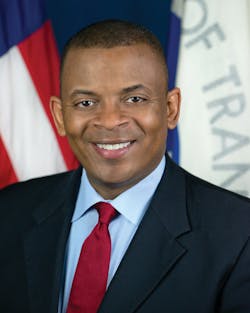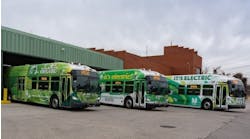ERIN, USE THIS INFO AS A PULLOUT BOX
Name: Anthony Foxx
Title: 17th United States Secretary of Transportation
Date of Swearing in: July 2, 2013
Prior Positions: Mayor of Charlotte, North Carolina, 2009 – 2013
At-Large Representative, Charlotte City Council
Chair, Mecklenburg-Union Metropolitan Planning Organization
Notable Accomplishments: Extending the LYNX light rail system; Expanding Charlotte-Douglas International Airport; Working with North Carolina Governor Beverly Perdue to accelerate the I-485 outer belt loop using a creative design-build-finance approach, the first major project of its kind in North Carolina; and initiating the Charlotte Streetcar project.
Family: Mr. Foxx and his wife, Samara, have two children, Hillary and Zachary
On July 2, former Charlotte Mayor Anthony Foxx was sworn in as the 17th U.S. secretary of transportation during a private ceremony at the department of transportation’s headquarters. Foxx is the youngest member of President Barack Obama’s cabinet. He replaced outgoing Secretary Ray LaHood, former Republican Illinois Congressman who served as secretary from 2009 until 2013.
Foxx will have a tough act to follow in LaHood, who was elected to the House of Representatives in 1994 and leveraged his substantial ties with lawmakers at the department to advance the objectives of the Obama Administration. LaHood managed billions in spending on infrastructure, from bike pathways to high-speed rail, as part of the economic stimulus, budget appropriations, and TIGER grants.
Foxx understands his challenges as the new secretary and has already shared his top priority. In a statement released to the media, Foxx said, “Safety will remain our top priority at the department of transportation. At the same time, I will work to improve the efficiency and performance of our current transportation system while building the infrastructure we need for future generations.” He added, “In doing so, I look forward to bringing my ‘on the ground’ experiences as a mayor, while embracing the tremendous knowledge, skill and ingenuity of the DOT workforce and our many stakeholders.”
The Road Ahead
As U.S. secretary of transportation, Foxx will head an agency with more than 55,000 employees and a $70 billion budget that oversees the nation’s highway, transit, aviation, maritime and rail transportation issues. His primary goal is to ensure that America maintains the safest, most efficient transportation system in the world. In a statement to the media, Foxx said, “Safer, more efficient transportation can make a difference in every American’s life. I’ve seen it firsthand in Charlotte, and I’m looking forward to continuing the president’s commitment to improve transportation in communities across the country.”
Among other goals, Foxx plans to secure a sustainable funding stream for badly needed improvements to roads, bridges and transit systems. A process that began in 2004, the U.S. Department of Transportation struggled to replace the country’s radar-based air traffic control system, which dates to the 1950s, with a modern, satellite-based system due to significantly decreased revenue from the Highway Trust Fund. The Highway Trust Fund, which was created in the 1950s to fund the construction and maintenance of the Interstate Highway System, is quickly disappearing. One problem for the Highway Trust Fund is that Americans are driving less and they are driving more fuel-efficient cars, such as hybrids and electric cars. The fund depends on federal gasoline tax revenue which in recent years has become an insufficient source of support, and Congress has bailed it out with more than $50 billion from the U.S. Treasury over the past five years. The 18.4-cents-gallon-tax has remained unchanged in two decades and Foxx will need to consider whether to lobby the president on replacing it with something else.
Budgeting and finance-sourcing is a serious concern for the new secretary as he could be influential in deciding whether local and state governments receive federal funding for future projects. For instance, the city of Charlotte is seeking a $63 million federal grant to build the streetcar line that Foxx spearheaded as mayor last year. The project did not receive funding but remains likely to get support. In addition, North Carolina hopes to build a high-speed rail from Charlotte to Raleigh, another project Foxx supports.
In nominating Foxx, Obama said, “I know Anthony’s experience will make him an outstanding transportation secretary.” Prior to Foxx’s swearing in, the White House released a statement from the president stating, “Anthony knows firsthand that investing in our roads, bridges and transit systems is vital to creating good jobs and ensuring American businesses can grow and compete in a 21st century global economy.”
The president’s comments stem from Foxx’s career accomplishments as the mayor of Charlotte from 2009 to 2013 and his experience with transportation issues, such as the expansion of Charlotte’s light-rail line, a new intermodal rail yard under construction at Charlotte-Douglas International Airport and the implementation of several critical highway projects.
A Mayor with a Plan
Foxx was elected as mayor on Nov. 3, 2009, winning 51.5 percent of the vote and defeating his city council colleague, Republican John Lassiter. He won a second term on Nov. 8, 2011, winning more than two-thirds of the vote against Republican Scott Stone. Originally elected at the age of 38, Foxx was the youngest mayor of Charlotte and was the first Democrat to hold the office since Harvey Grant who left office in 1987. He was Charlotte’s second African American mayor, as well as its first newly elected mayor since 1995, when Pat McCrory began the first of his record seven terms in office. The Senate confirmed the president’s nomination of Foxx to the post of secretary of transportation on a vote of 100-0, a honor shared with few nominees. U.S. Sen. Jay Rockefeller (D-WV.) said Foxx would be a “superb” leader of the nation’s transportation system.
Early in his political career, Foxx gained a reputation as a quick study of local policy, leading a number of city council initiatives, including the development of policies to enhance job creation into the urban core of Charlotte, environmental efforts that led to a single stream recycling program and greenhouse gas reduction policies, and acceleration of the region’s transit plan.
As mayor, Foxx set three goals: strengthening and diversifying the area economy, improving quality of life, and building stronger relationships with Raleigh and Washington, D.C. During his tenure as mayor, while facing a nearly 13 percent area unemployment rate, Foxx announced the creation of more than 4,000 new jobs. He also worked to reinforce Charlotte’s role as a critical energy industry hub, hosted a series of town hall meetings with unemployed workers, pushed for changes to the city’s small business loan program to create jobs, saw the completion of a new runway at Charlotte-Douglas International Airport, and led a delegation of Charlotte business leaders to meet with senior White House officials to initiate several economic recovery spending measures.
Foxx made several significant investments as mayor in transportation and made their implementation the cornerstone of augmenting Charlotte’s job creation and economic recovery efforts. Such investments include expanding Charlotte-Douglas International Airport; working with North Carolina Gov. Beverly Perdue to accelerate the I-485 outer belt loop using a creative design-build-finance approach; championing the Charlotte Streetcar project; and extending the LYNX light rail system, which will build new roads, bridges, transit as well as, bicycle and pedestrian facilities.
Two other ex-mayors have become transportation secretary. Federico Peña, who was the first transportation secretary under President Bill Clinton, had been mayor of Denver. The second, Neil Goldschmidt was mayor of Portland, Ore., before becoming Jimmy Carter’s secretary of transportation in 1979.
Career Driven By Transportation
Prior to his election as mayor, Foxx was elected to the Charlotte City Council in 2005 and served two terms as an at-large representative. As a council member, Foxx was the chair of the transportation committee, where he spearheaded the largest transportation bond package in the city’s history enabling Charlotte to take advantage of all-time low interest rates and favorable construction pricing to maximize use of city funding beyond initial projections. He was also a member of the economic development and planning committee, and served as council’s representative to the Charlotte-Mecklenburg Development Corp. and the Mecklenburg-Union Metropolitan Planning Organization.
Foxx is an attorney and has spent much of his career in private practice. He also served as a law clerk for the U.S. Sixth Circuit Court of Appeals which includes Kentucky, Michigan, Ohio, and Tennessee; a trial attorney for the civil rights division of the U.S. Department of Justice; and staff counsel to the U.S. House of Representatives Committee on the Judiciary. Foxx received his law degree from New York University’s School of Law as a Root-Tilden Scholar, the university’s prestigious public service scholarship. He earned his bachelor’s degree in history from Davidson College. Foxx has been recognized as on of The Charlotte Business Journal’s “40 Under 40” and received the National Carolina Bar Association’s Citizen Lawyer Award.
Road Blocks and Construction Ahead
Since taking office at DOT, Foxx has accepted Obama’s challenge of cutting waste and red tape. One of his first proposed rules would reduce trucking paperwork, saving the industry $1.7 billion a year. Currently, truckers are required to file inspection reports on every trip a commercial truck makes. Under Foxx’s proposed rule, truckers would only be required to file inspection reports if a defect is found, which affects roughly 5 percent of inspections. In addition, Foxx continues to defend the current hours of service rule that regulates the number of hours truckers may drive before taking a required break.
Foxx echoes President Obama’s sentiment regarding the government shutdown, expressing disappointment and gratitude to the over 18,000 furloughed department of transportation employees. He hoped for a quick resolution “so that we can all get back to work ensuring the safety and efficiency of our nation’s transportation systems.”
During the government shutdown in October, Foxx did not utilize the department of transportation’s social media accounts, including Twitter or the DOT blog. On Oct. 18, Foxx returned to Twitter to welcome the 18,000 furloughed DOT employees and said, “It’s great to be at full-strength again!”
He faces another potential government shutdown in January and will likely be faced with proposed budget cuts from the Tea Party caucus.
Foxx, a family man who often brings his wife and kids to D.C events, seems comfortable in the role and will likely advance an aggressive agenda for technological advancements in the safety, security, and speed of our nation’s transportation systems. If his past accomplishments are any indication of his future accomplishments as secretary of DOT, Anthony Foxx will be boarding a high-speed train to future political office.
Thomas Hart, an attorney in Washington, D.C., is a founder and board member of the U.S. High Speed Rail Association and the president of Railforward.



